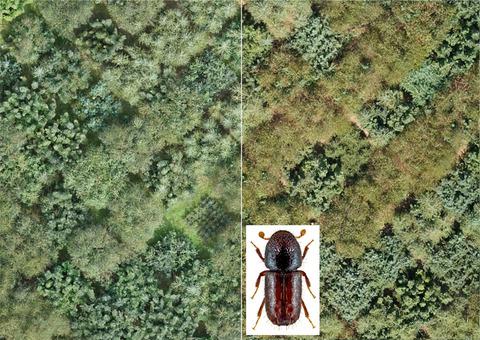Our official English website, www.x-mol.net, welcomes your feedback! (Note: you will need to create a separate account there.)
Tree diversity reduces the risk of bark beetle infestation for preferred conifer species, but increases the risk for less preferred hosts
Journal of Ecology ( IF 5.5 ) Pub Date : 2021-05-16 , DOI: 10.1111/1365-2745.13672 Sylvie Berthelot 1 , Tobias Frühbrodt 2 , Peter Hajek 3 , Charles A. Nock 3, 4 , Carsten F. Dormann 1 , Jürgen Bauhus 5 , Jochen Fründ 1
中文翻译:

树木多样性降低了首选针叶树种树皮甲虫侵染的风险,但增加了不太喜欢的寄主的风险
更新日期:2021-07-09
Journal of Ecology ( IF 5.5 ) Pub Date : 2021-05-16 , DOI: 10.1111/1365-2745.13672 Sylvie Berthelot 1 , Tobias Frühbrodt 2 , Peter Hajek 3 , Charles A. Nock 3, 4 , Carsten F. Dormann 1 , Jürgen Bauhus 5 , Jochen Fründ 1
Affiliation

|
- In recent decades, European temperate forests have repeatedly suffered from severe droughts. Drought-weakened forests have often become more susceptible to pest outbreaks such as bark beetle infestations. Tree species diversity is expected to increase resistance to drought and pests, but evidence for a positive tree diversity effect on insect pest reduction is largely circumstantial.
- Here we tested the effects of tree diversity and biogeographic origin of tree species on bark beetle infestation in a large, young tree diversity experiment, with six broadleaved and six conifer species from Europe and North America. Lower infestation risk was expected for the exotic tree species in each congeneric pair (spruce, larch and pine) and for mixtures with higher species richness and higher broadleaf proportion. Following a severe drought in summer 2018, the conifer trees were attacked by the six-toothed spruce bark beetle Pityogenes chalcographus. Bark beetle boreholes were recorded in winter 2018/2019 on all conifer species.
- Norway spruce Picea abies and European larch Larix decidua were the most infested species and thus considered main hosts of the bark beetle. For these two species, probability of infestation decreased with increasing tree diversity (although this was only significant for Larix). In contrast, Pinus, which were less infested overall, were more likely to be infested in plots with high tree diversity. Exotic trees tended to be less infested, with clearest support for enemy release found at the level of infestation intensity when considering pure conifer stands. Overall, the effects of tree diversity and tree species origin were not as strong as the effect of position within the experimental site, where higher rates of infestation were observed at the edge than in the centre.
- Synthesis. Increasing tree diversity may reduce the risk of bark beetle infestation for genera prone to high infestation rates (Picea and Larix), but risk for less preferred genera (Pinus, and to some extent the exotic tree species) may increase with tree diversity due to spillover from preferred hosts. In mixed forests, the risk of infestation, even by relatively specialized insect pests, may be redistributed among tree species rather than reduced for all.
中文翻译:

树木多样性降低了首选针叶树种树皮甲虫侵染的风险,但增加了不太喜欢的寄主的风险
- 近几十年来,欧洲温带森林一再遭受严重干旱。干旱减弱的森林往往更容易受到树皮甲虫等害虫爆发的影响。预计树种多样性会增加对干旱和害虫的抵抗力,但树木多样性对减少害虫有积极影响的证据在很大程度上是间接的。
- 在这里,我们在一项大型幼树多样性实验中测试了树木多样性和树种的生物地理起源对树皮甲虫侵扰的影响,实验包括来自欧洲和北美的六种阔叶树和六种针叶树种。预计每一对同类中的外来树种(云杉、落叶松和松树)以及具有较高物种丰富度和较高阔叶比例的混合物的侵染风险较低。在 2018 年夏季严重干旱之后,针叶树遭到六齿云杉树皮甲虫Pityogenes chalcographus 的袭击。2018/2019 年冬季,所有针叶树物种都记录了树皮甲虫钻孔。
- 挪威云杉冷杉和欧洲落叶松落叶松是受侵染最多的物种,因此被认为是树皮甲虫的主要宿主。对于这两个物种,侵染概率随着树木多样性的增加而降低(尽管这仅对落叶松显着)。相比之下,松,总体上受侵染较少,更有可能在树木多样性高的地块中受侵染。外来树木往往较少受到侵扰,在考虑纯针叶林时,在侵扰强度水平上发现对敌人释放的最明确支持。总体而言,树木多样性和树种起源的影响不如实验地点内位置的影响那么强烈,在边缘处观察到的侵染率高于中心。
- 合成。增加树木多样性可能会降低易受侵染率高的属(云杉和落叶松)的树皮甲虫侵染的风险,但由于溢出,树木多样性可能会增加不太优选的属(松属,以及在一定程度上外来树种)的风险来自首选主机。在混交林中,即使是相对专门的害虫侵染的风险,也可能在树种之间重新分配,而不是降低所有树种。



























 京公网安备 11010802027423号
京公网安备 11010802027423号